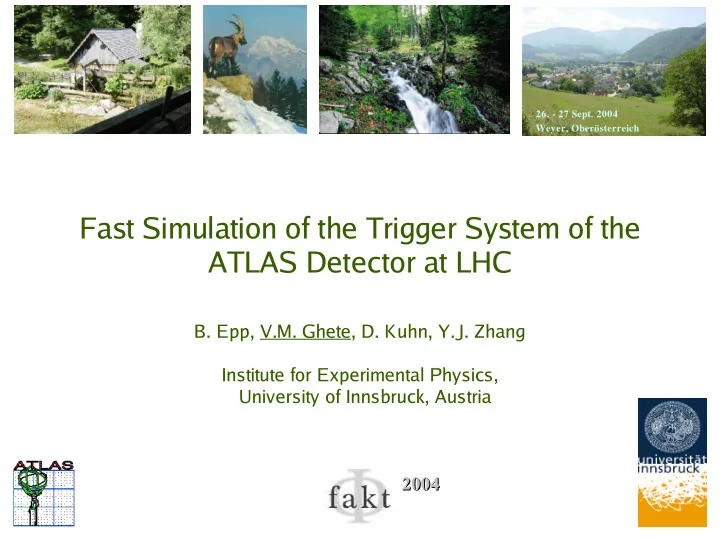

26. - 27 Sept. 2004 Weyer, Oberösterreich Fast Simulation of the Trigger System of the ATLAS Detector at LHC B. Epp, V.M. Ghete, D. Kuhn, Y.J. Zhang Institute for Experimental Physics, University of Innsbruck, Austria 2004 2004
Introduction Fast simulation: use particle-level information only (i.e. generator output) no full detector simulation needed Aims / objectives: provide a tool for overall LVL1 + HLT optimization and strategy development provide fast trigger response for offline studies - compute approximate trigger rate and efficiencies - enable production of trigger-selected sample Approach: parametrized distributions, determined from full simulation possibly combined with simplified (averaged) detector description Relation between full and fast simulation: fast simulation integrated with full simulation (common interfaces) use full simulation framework for steering, configuration, etc. 2
ATLAS Trigger System Level-1 trigger (LVL1) selection: based on reduced- granularity information from calorimeter and muon trigger chambers provides Region of Interest ( η , φ of LVL1 signature, p T and energy sum of candidate objects) to LVL2 Level-2 trigger (LVL2) has access to all event data, with full precision and granularity Trigger tasks: uses LVL1 RoIs to access selectively reduce the total event rate to ~200 Hz, data, transfer minimum required data most dedicated to high-p T physics emphasis: fast rejection & algorithms maximize coverage of discovery Event Filter (EF) physics refines LVL2 selection, using LVL2 be open to new signatures RoIs and sophisticated algorithms use inclusive triggers as much as can access detailed alignment and possible calibration data 3
Full Simulation of LVL1 Trigger Purpose: identify basic signatures of interesting physics muons em/tau/jet calorimeter clusters missing/sum E T LVL1 decision based on multiplicities and thresholds thresholds are programmable Full simulation of LVL1 package TrigT1, with algorithms for calorimeter trigger: TrigT1Calo muon trigger: TrigT1TGC, TrigT1RPC can be use to obtain parametrized distributions: e.g. for muons, provides efficiency and acceptance maps 4
HLT Event Selection Software HLT Selection Software H LT D ata Flow Softw are Framework ATHENA/GAUDI E vent Filter Reuse offline components HLTSSW Common to Level-2 and EF Processing H LT C ore S oftw are Task Steering Level2 Monitoring Service HLT Algorithms L2PU Application Data HLT Manager Algorithms ROB Data Collector Event Data MetaData Service Model <<import>> O ffline algorithms used in <<import>> <<import>> <<import>> EF Package Athena/ Event Data Reconstr. StoreGate Model Gaudi Algorithms Interface O ffline R econstruction O ffline C ore Softw are Dependency 5
LVL1 Muon Trigger: Input for Fast Simulation Running full simulation to obtain: trigger efficiency versus p T for various muon p T thresholds acceptance maps as a function of η and φ ↑ Look-up maps MuTruth → Fast Trigger Algorithm → Yes/No 6
Overview of Algorithms and Framework LVL1 fast algorithms run in a private AtlfastTrigT1Steer package LVL2 fast algorithms run in the general TrigSteer framework have the same interface as full simulation algorithms AtlfastTrigT1Steer “clone” of TrigSteer 7
Architecture of AtlfastTrigT1Steer Class diagram of the HLT TrigSteer package Class diagram of the LVL1 AtlfastTrigT1Steer package 8
McConversion McConversion Creates for every generated muon a pair {MuTruth object, trigger element (TE)} an example of the “separation of data and algorithms” using StoreGate mechanism Diagram: simplified version 9
Sequence Diagram of a LVL1 Algorithm 10
Sequence Diagram of a LVL2 Algorithm 11
Final Remarks Fast simulation of the trigger system: useful tool for evaluation of feasibility for new physics studies trigger strategy and optimization Development of the software: depends strongly on full simulation to obtain the parametrizations for general framework (steering, configuration, etc.) Status: not yet collaboration-wide available good progress for the muon trigger slow development of the calorimeter trigger (external dependencies, major re-write of offline software – now close to usability) Target for (partial) implementation: ATLAS Physics Workshop (Rome, June 2005) 12
Recommend
More recommend